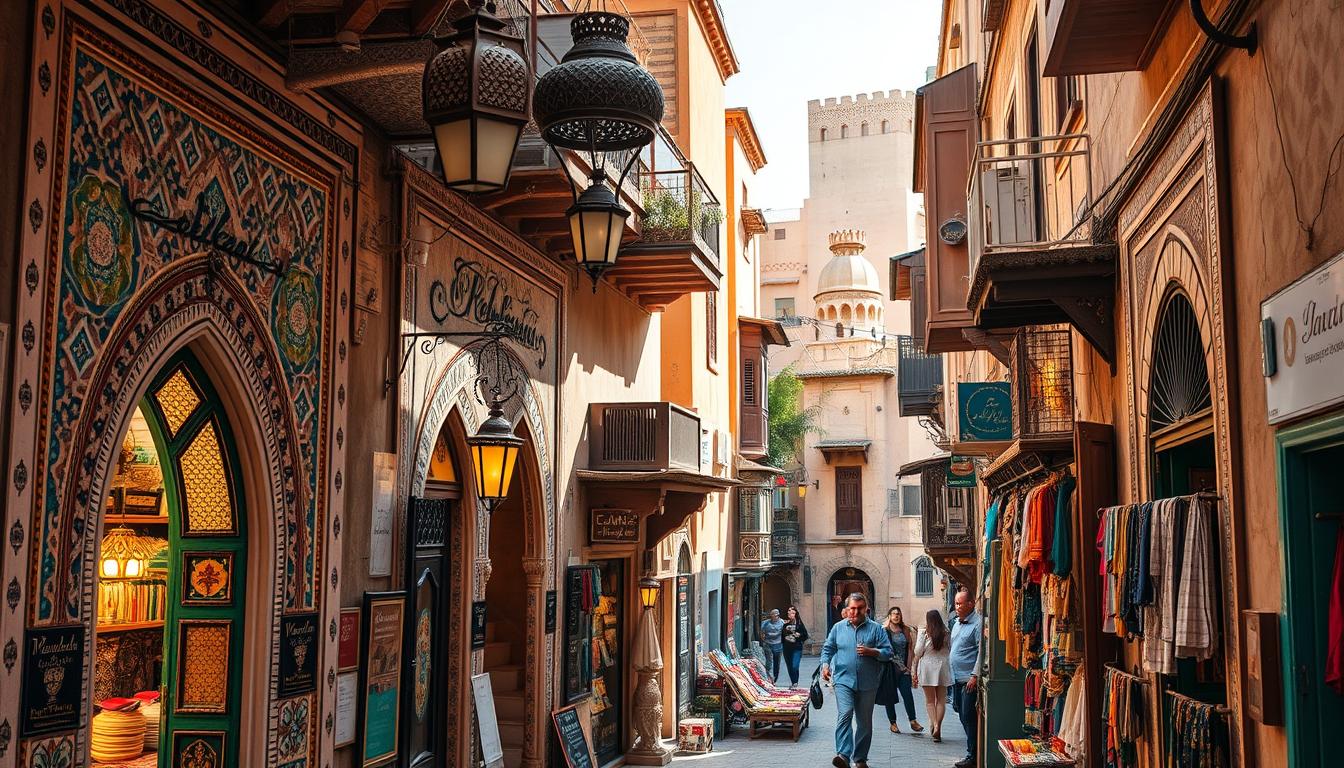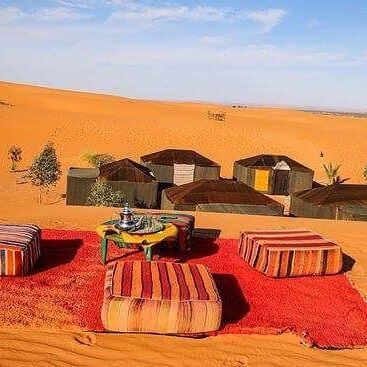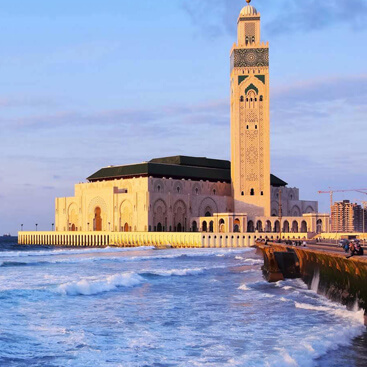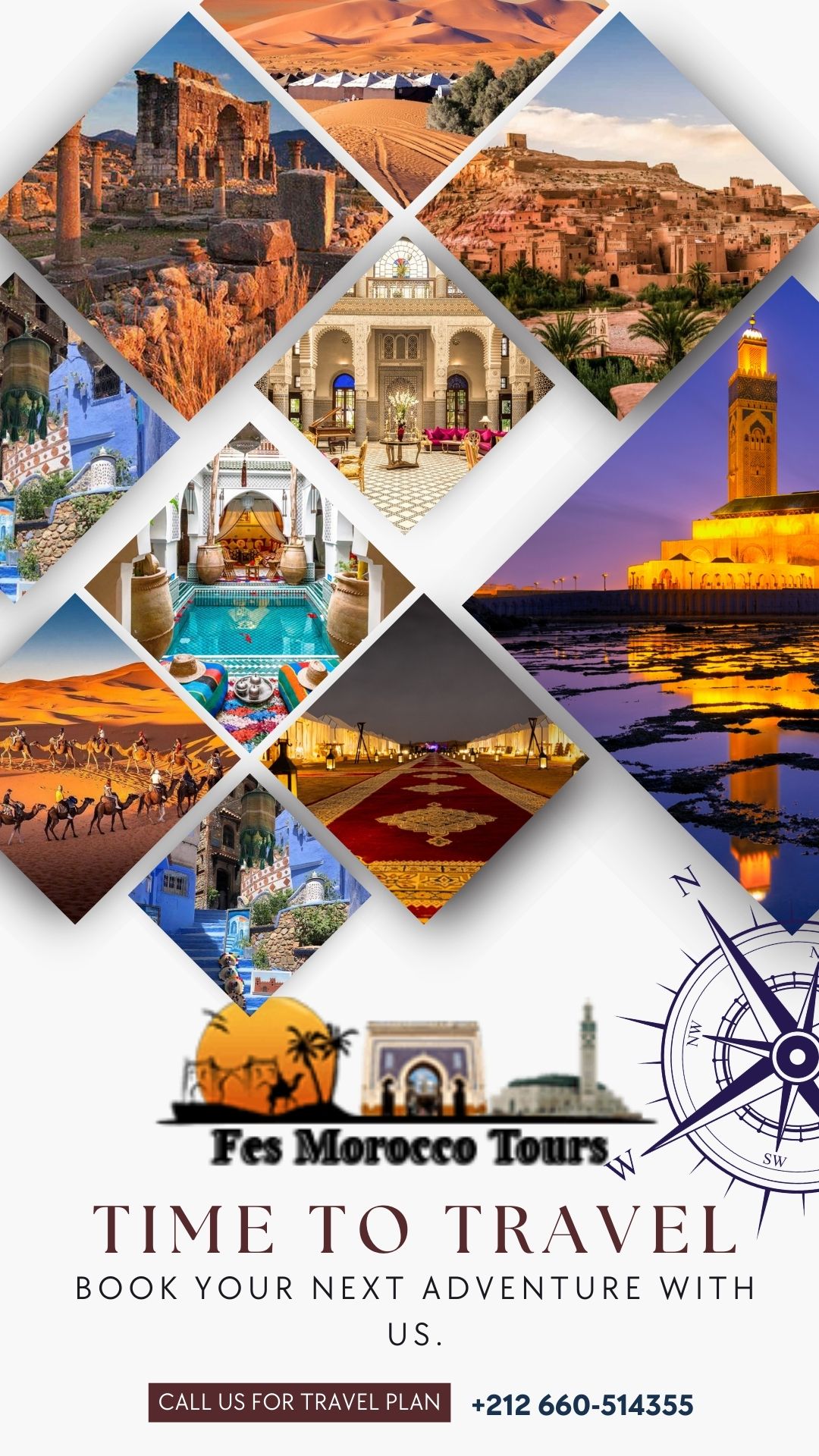
Visit Fes Morocco: Ancient Imperial City & Culture
As I walked through Fes, Morocco's oldest imperial city, I felt like I stepped back in time.
The streets of the UNESCO-listed Medina were alive with color and sound. You can hear the clang of metal and smell the spices everywhere.
Fes is more than a place to visit. It's a living piece of Morocco's history and culture. It's a mix of old architecture, delicious food, and rich traditions.
Fes Morocco
"Vibrant streets of Fes Medina, intricate blue and yellow tile mosaics, bustling market stalls with colorful textiles and spices, traditional Moroccan archways, lively atmosphere with artisans at work, historical buildings under a clear sky."
Key Takeaways
- Fes, the oldest imperial city in Morocco, dates back to the 9th century and has served as the country's capital through various dynasties.
- The Medina of Fes el Bali, a UNESCO World Heritage site, is the world's largest car-free urban area, with a labyrinth of narrow streets and alleyways.
- Fes is home to the world's oldest university and attracts scholars, backpackers, and foodies alike with its rich cultural offerings.
- The Chaouwara Tanneries, believed to be the oldest operating tannery globally, offer a glimpse into Fes's ancient leather-making traditions.
- Fes boasts a diverse culinary scene, from traditional Moroccan delicacies to innovative fine dining experiences, providing a tantalizing journey for the senses.
Introduction to Fes: Morocco's Cultural Heart
Fes is Morocco's spiritual and cultural heart, mixing old history with modern life. It has three main areas: Fes el Bali (the old medina), Fes el Jdid (the new medina), and Ville Nouvelle (the modern city). This makes Fes a perfect example of Morocco's rich past, including the Andalusian influence and the Marinid dynasty.
Historical Significance and UNESCO Status
Fes was founded in the 9th century, making it one of Morocco's oldest cities. It's a UNESCO World Heritage Site, known for its medieval architecture and urban planning. The medina of Fes el Bali is the largest car-free area in the world, showing the city's commitment to its heritage.
Overview of Fes's Three Districts
- Fes el Bali: The old medina, a bustling hub of activity showcasing a blend of Arab, Berber, and Andalusian influences.
- Fes el Jdid: The new medina, which was established in the 13th century during the Marinid dynasty.
- Ville Nouvelle: The modern city, which developed during the French protectorate period in the early 20th century.
Each district offers a unique glimpse into Fes's rich history and cultural tapestry. It's a must-visit for anyone exploring Morocco's heart.
Fes el Bali
A vibrant street scene in Fes el Bali, showcasing the ornate architecture with intricate tilework and colorful doorways, bustling narrow alleys filled with artisans and merchants, traditional Moroccan lanterns hanging overhead, a warm golden light filtering through the winding passageways, and glimpses of the historic medina in the background.
"Fes is the soul of Morocco, a living museum where time seems to have stood still."
Navigating the Ancient Medina of Fes el Bali
The ancient medina of Fes el Bali is at the heart of Fes. It's a maze that takes you back in time. With over 9,000 narrow streets, it's a place to dive deep into Moroccan crafts and culture. Exploring it with a local Fes medina tours guide is the best way to see its wonders.
Walking through the medina, you'll see, hear, and smell Moroccan crafts. You'll find artisan workshops and lively visit Fes souks. Every corner has something new to discover, like leather goods, spices, and textiles.
The medina also has historical and religious sites that are amazing. You can see the Kairaouine Mosque, the oldest university, and the Medersa Bou Inania. These places show Fes's rich history and its role in Islamic learning and spirituality.
The medina of Fes el Bali is a place of wonder. It's full of artisan workshops, historical sites, and lively souks. It's a key part of the Moroccan crafts, Fes medina tours, and visit Fes experience.
The Famous Chaouwara Tanneries: A Living History
Explore the world of Moroccan craftsmanship at the Chaouwara Tanneries in Fes. These leather-making facilities date back to the 11th century. They offer a peek into the traditions that have shaped Fes's culture.
Traditional Leather Making Process
See the leather-making process up close. Workers dye hides in large stone vats with natural dyes. This method has stayed the same for centuries.
Watch as they turn raw animal skins into high-quality leather. This is why Fes is famous for its leather crafts.
Best Viewing Points and Shopping Tips
The best spots to see the tanneries are from nearby leather shops. They often give out mint leaves to help with the smells. Look around and buy leather products like bags, belts, and accessories. Talk to the artisans and try to get a good deal. This way, you can take home a piece of Fes's culture.
Optimal Visiting Times
Visit the Chaouwara Tanneries in the early morning. This is when it's most lively. You'll see the workers at their best and enjoy the sights and sounds.
"Fez is now replacing Marrakesh as Morocco's most exotic destination."
Religious and Educational Landmarks in Fes Morocco
Fes, Morocco's cultural heart, is filled with religious and educational landmarks. These sites show the city's Islamic heritage and Andalusian influence. The University of Al Quaraouiyine, founded in 859 AD, is the oldest continuously operating university in the world.
The city's mosques, like the Andalusian Mosque and the Mosque of the Andalusians, are architectural wonders. They feature intricate Islamic architecture, including detailed tile work, carved woodwork, and elaborate stucco designs. These structures are not just places of worship but also symbols of the city's deep connection to its Andalusian influence.
Visiting the University of Al Quaraouiyine is a must for those interested in Fes's educational legacy. This renowned institution has been a hub of learning for centuries. Scholars and students from all over the world come here. Visitors can explore the campus and see the timeless traditions of Islamic scholarship that continue to thrive.
Fes offers a Fes Morocco tours experience that is truly unique and unforgettable. It lets you dive into the rich tapestry of Moroccan culture. Discover the hidden gems that make this ancient imperial city a true jewel of North Africa.
Architectural Treasures: Madrasas and Palaces
Fes, Morocco's cultural heart, is filled with Islamic architecture that draws visitors worldwide. The city's madrasas and palaces are architectural wonders. They showcase incredible craftsmanship and design.
Medersa Bou Inania's Intricate Design
The Medersa Bou Inania is a 14th-century madrasa in Fes. It's famous for its stunning zellij tilework, carved cedar wood, and detailed stucco. Built under the Marinid dynasty, it's a masterpiece of Islamic art and design.
Royal Palace and Its Golden Gates
The Royal Palace in Fes is not open to the public. But its grandeur and golden gates make a lasting impression. This palace complex is a symbol of Moroccan culture and Islamic architecture. It's a must-see for those exploring Fes's rich history and heritage.
Al-Attarine Medersa's Artistic Heritage
The Al-Attarine Medersa is another architectural gem in Fes. Known as the "madrasa of the perfumers," it's a 14th-century masterpiece. Located near the perfume and spice market, it features intricate designs inspired by Moroccan culture. It's a testament to Fes's enduring artistic legacy.
"Fes's architectural treasures are a testament to the enduring legacy of Islamic architecture and the rich Moroccan culture that has shaped this ancient city."
Traditional Crafts and Artisan Quarters
Fes, Morocco's cultural heart, is famous for its vibrant artisan tradition. Walking through Fes el Bali's ancient medina, you'll find many workshops. They specialize in authentic Moroccan crafts, like ceramics and textiles.
At the Art Naji ceramic workshop, you can see master craftsmen at work. They shape and decorate clay into beautiful pieces that show Moroccan design. The Seffarine Square is where Fes's coppersmiths work. The sound of hammers creates a captivating symphony.
The Nejjarine Square is filled with fine woodwork. You'll see beautifully carved furniture and architectural details. It's a great place for anyone interested in Moroccan craftsmanship.
"Fes is a living museum of Moroccan crafts, where you can witness the creation of timeless masterpieces right before your eyes."
Exploring Fes el Bali's labyrinth, don't miss the artisan quarters. They show the heart of Moroccan crafts. A visit to Fes is a journey into Morocco's rich culture.
Culinary Journey Through Fes
Fes, Morocco's ancient imperial city, is a food lover's dream. It mixes Arab, Berber, Mediterranean, and Andalusian flavors. Here, you can find local treats and top restaurants, all serving authentic Moroccan dishes.
Local Delicacies and Street Food
Explore Fes's lively medina to taste its vibrant flavors. Try b'stilla, a pastry pie with spiced meat, and khobz, the famous semolina bread. Street food stalls offer everything from juices to grilled meats.
Top Dining Establishments
Fes has many excellent restaurants for a fancy meal. Nur is known for its creative Moroccan dishes with a modern twist. Other places serve traditional tagines and more.
Cooking Classes and Food Tours
Take a cooking class at Fez Cooking School or Cafe Clock. You'll learn to make classic dishes and blend spices with local chefs. Join a food tour of Fes to explore its food culture. Visit markets, try street food, and learn about Moroccan cuisine.
Whether you love food or just want to try new things, Fes is a must-visit. It will excite your taste buds and make you appreciate Moroccan cuisine even more.
Jewish Heritage and the Mellah District
Fes, Morocco's cultural heart, has a rich Jewish heritage. The Mellah, the historic Jewish quarter, shows how different communities lived together. It was set up in 1438, making it one of the oldest Jewish areas in the world.
In the Mellah, you'll see the Ibn Danan Synagogue, a mix of Moroccan and Jewish art. The Slat Al Fassiyin synagogue, the oldest in the Mellah, was beautifully restored in 2013. The Aben Danan Synagogue, from the 17th century, was also renovated and became a UNESCO World Heritage Site in 1999.
The Mellah's buildings, with balconies facing the streets, are different from Muslim areas. This shows the city's diverse past. The Jewish cemetery in Fes, with over 22,000 tombs, was fully restored in 2015. It now serves as a museum and a place for prayer for those interested in Moroccan culture and Fes Morocco tours. Discover the Jewish heritage and dive into the fascinating history of this lively visit Fes district.
FAQ
What is the historical significance of Fes, Morocco?
Fes, Morocco's oldest imperial city, was founded in 789. It has been the country's capital through various dynasties. It's a UNESCO World Heritage site, known for its rich culture, colors, and philosophy.
What are the distinct areas of Fes?
Fes is divided into three areas: Fes el Bali (the old medina), Fes el Jdid (the new medina), and Ville Nouvelle (the modern city). The medina of Fes el Bali is the largest car-free urban area in the world.
What is it like to navigate the medina of Fes el Bali?
The medina of Fes el Bali is a maze of over 9,000 narrow streets and alleyways. It's challenging but rewarding to explore. Visitors should hire a guide to fully appreciate its complexity and discover its hidden gems.
What are the must-see attractions in the Fes medina?
Key attractions in the Fes medina include the leather tanneries, traditional souks, and madrasas (Islamic schools). The Chaouwara Tanneries show traditional leather-making. Artisan workshops showcase centuries-old crafting techniques.
What are the notable religious and educational landmarks in Fes?
Fes is home to the University of Al Quaraouiyine, the oldest continuously operating university in the world. The city also has impressive mosques, like the Andalusian Mosque and the Mosque of the Andalusians. These show the city's rich Islamic heritage and architectural beauty.
What are the architectural highlights in Fes?
Fes is known for its stunning madrasas and palaces, such as the Medersa Bou Inania and the Al-Attarine Medersa. They feature exquisite zellij tilework, carved cedar wood, and stucco decoration.
What is the culinary experience like in Fes?
Fes offers a rich culinary experience, blending Arab, Berber, Mediterranean, and Andalusian influences. Local delicacies include b'stilla (a flaky pastry pie), khobz (semolina bread), and various tagines. Visitors can explore the vibrant street food scene and enjoy fine dining at restaurants like Nur.
What is the significance of the Mellah district in Fes?
Fes has a significant Jewish heritage, evident in its well-preserved Mellah (Jewish quarter). The Ibn Danan Synagogue, one of the oldest in North Africa, shows the city's diverse religious history and the coexistence of different cultures in Fes throughout history.
Related Tours

Marrakech to zagora 2 days
It is a long established fact that a reader will be distracted by the readable content
Read More2 Days
Marrakech to zagora

Marrakech to fes desert tours 2 days
It is a long established fact that a reader will be distracted by the readable content
Read More2 days
Marrakech to fes desert tours

Casablanca desert tours 8 days
It is a long established fact that a reader will be distracted by the readable content
Read More